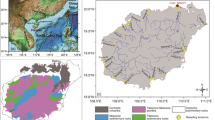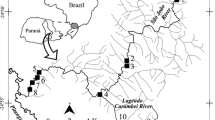Abstract
This study demonstrates that prior to Typhoon Morakot, the index of heavy metals such as Cd, Pb, and Cr was above moderate pollution levels in Dapeng Bay and the three neighboring rivers. During January 2007, the content of Zn metal in Dapeng Bay and Tungkang River was also above moderate pollution levels, while after the Typhoon Morakot event, all metals were at levels below the criteria for low pollution. This work has demonstrated that the samples collected from Dapeng Bay and the three neighboring river systems displayed individual crowd–distribution phenomena, indicating variability between the heavy metal content of sediments collected from Dapeng Bay and the three neighboring rivers. Understanding the spatial and temporal variability of heavy metal pollutants in the sediments of Dapeng Bay, along with pollution sources from three neighboring rivers, provides useful information in the fields of disaster management, habitat recovery, operative management, as well as ecotourism specification.






Similar content being viewed by others
References
Borovec, Z., Tolar, V., & Mraz, L. (1993). Distribution of some metals in sediments of the central part of the Labe (Elbe) river: Czech Republic. AMBIO, 22, 200–205.
Calmano, W., Wolfgang, A., & Forstner, U. (1990). Exchange of heavy metals between sediment components and water. In J. A. C. Broekaert, S. Gucer, & F. Adams (Eds.), Metal speciation in the environment (NATO ASI Ser, Ser G, Vol. 23, pp. 503–522). Berlin: Springer.
Chen, M. H., & Hung, T. W. (1995). Cooper, cadmium and lead in sediments from Kaohsiung River and its harbor area, Taiwan. Marine Pollution Bulletin, 30(12), 879–884.
Chung, C. Y., Chen, J. J., Lee, C. G., Chiu, C. Y., Lai, W. L., & Liao, S. W. (2011). Integrated estuary management for diffused sediment pollution in Dapeng Bay and Neighboring Rivers (Taiwan). Environmental Monitoring and Assessment, 173(1), 499–517.
Cook, J. A., Andrew, S. M., & Johnson, M. S. (1990). Lead, zinc, cadmium and fluoride in small mammals from contaminated grass-land established on fluorspar tailings. Water, Air, and Soil Pollution, 51, 43–54.
Cruz-Castillo, J., Ganeshanandam, S., Mackay, B. R., Lawes, G. S., & Woolley, D. J. (1994). Application of canonical discriminant analysis in horticultural re-search. HortScience, 29, 1115–1119.
Deniseger, J., Erickson, J., Austin, A., Roch, M., & Clark, M. J. R. (1990). The effects of decreasing heavy metal concentrations on the biota of Buttle Lake. Water Research, 24, 403–416.
Fang, T. H., & Lin, C. L. (2002). Dissolved and particulate trace metals and their partitioning in a hypoxic estuary: Tanshui estuary in northern Taiwan. Estuaries, 25, 598–607.
Fernandes, H. M. (1997). Heavy metal distribution in sediments and ecological risk assessment. The role of diagenetic processes in reducing metal toxicity in bottom sediments. Environmental Pollution, 97, 317–352.
Gibbs, R. J. (1973). Mechanisms of trace metal transport in rivers. Science, 180, 71–72.
Herr, C., & Gray, N. F. (1997). Sampling riverine sediments impacted by acid mine drainage: problems and solutions. Environmental Geology, 29, 37–45.
Jarvie, H. P., Whitton, B. A., & Neal, C. (1998). Nitrogen and phosphorus in east coast British rivers: speciation, sources and biological significance. Science of the Total Environment, 210(211), 79–109.
Johnson, R. A., & Wichern, D. W. (1992). Applied multivariate statistical analysis (3rd ed.). Englewood Cliffs: Prentice Hall.
Liao, S. W., & Chang, W. L. (2005). Interpretation and discrimination of marshy wetlands by soil factors in the Kuan-Tu Natural Park, Taiwan. Environmental Monitoring and Assessment, 107, 181–202.
Liao, S. W., Gau, H. S., Lai, W. L., Chen, J. J., & Lee, C. G. (2008). Identification of pollution of Tapeng Lagoon from neighboring rivers using multivariate statistical method. Journal of Environmental Management, 88(2), 286–292.
Lin, H. J., Dai, X. X., Shao, K. T., Su, H. M., Lo, W. T., Hsieh, H. L., Fang, L., & Hung, J. J. (2006). Trophic structure and functioning in a eutrophic and poorly-flushed lagoon in southwestern Taiwan. Marine Environmental Research, 62, 61–82.
Momen, B., & Zehr, J. P. (1998). Watershed classification by discriminant analyses of lake water-chemistry and terrestrial characteristics. Ecological Applications, 8, 497–507.
Müller, G. (1979). Schwermetalle in den sedimenten des Rheins-Veränderungen seitt 1971. Umschan, 79, 778–783.
Page, A. L. (Ed.). (1982). Methods of soil analysis, part 2—chemical and microbiological properties (2nd ed.). Madison: The American Society of Agronomy (ASA).
Rencher, A. C. (1992). Interpretation of canonical discriminant functions, canonical varieties, and principal components. American Statistician, 46, 217–225.
Simeonov, V., Stratis, J. A., Samara, C., Zachariadis, G., Voutsa, D., Anthemidis, A., Sofoniou, M., & Kouimtzis, T. (2003). Assessment of the surface water quality in Northern Greece. Water Research, 37, 4119–4124.
Simeonov, P., Simeonov, V., & Andreev, G. (2003). Water quality study of the Struma river basin, Bulgaria (1989–1998). Central European Journal of Chemistry, 2, 121–136.
Sin, S. N., Chua, H., Lo, W., & Ng, L. M. (2001). Assessment of heavy metal cations in sediments of Shing Mun River, Hong Kong. Environment International, 26, 297–301.
Singh, K. P., Malik, A., Mohan, D., & Sinha, S. (2004). Multivariate statistical techniques for the evaluation of spatial and temporal variations in water quality of Gomti River (India)—a case studies. Water Research, 38, 3980–3992.
StatSoft. (2006). STATISTICA for Windows. Tulsa: StatSoft, Inc.
Valerie, S., Clare, M. M. S., & Aoife, D. (2003). Microwave digestion of sediment, soils and urban particulate matter for trace metal analysis. Talanta, 60, 715–723.
Wei, L., Tieyu, W., Yonglong, L., John, P. G., Yajuan, S., & Yuanming, Z. (2007). Landscape ecology of the Guanting Reservoir, Beijing, China: multivariate and geostatistical analyses of metals in soils. Environmental Pollution, 146, 567–576.
Acknowledgments
This work was sponsored by the National Council of Science, Taiwan, and Republic of China (NSC 100-2632-E-127-001-MY3). The authors especially thank our colleagues at the Department of Environmental Resources Management who helped in the laboratory and with sampling.
Author information
Authors and Affiliations
Corresponding author
Rights and permissions
About this article
Cite this article
Tsai, YC., Chung, CY., Chung, CC. et al. The Impact of Typhoon Morakot on Heavy Metals of Dapeng Bay and Pollution from Neighboring Rivers. Environ Model Assess 21, 479–487 (2016). https://doi.org/10.1007/s10666-015-9474-2
Received:
Accepted:
Published:
Issue Date:
DOI: https://doi.org/10.1007/s10666-015-9474-2




